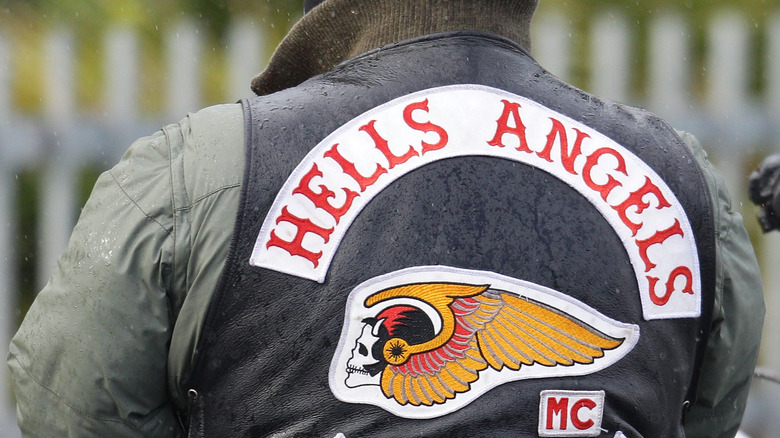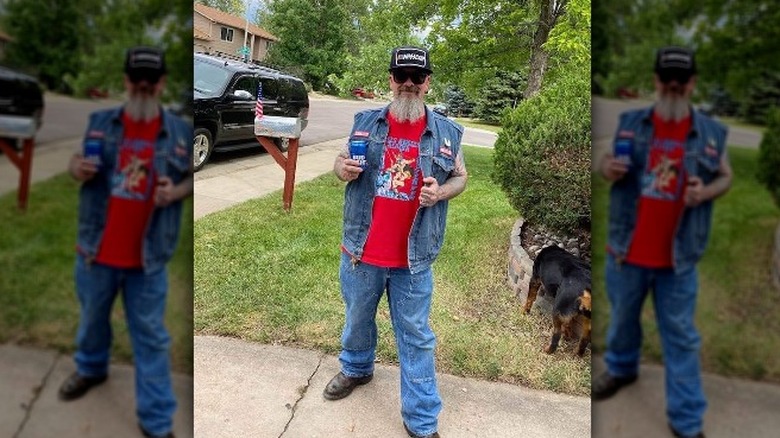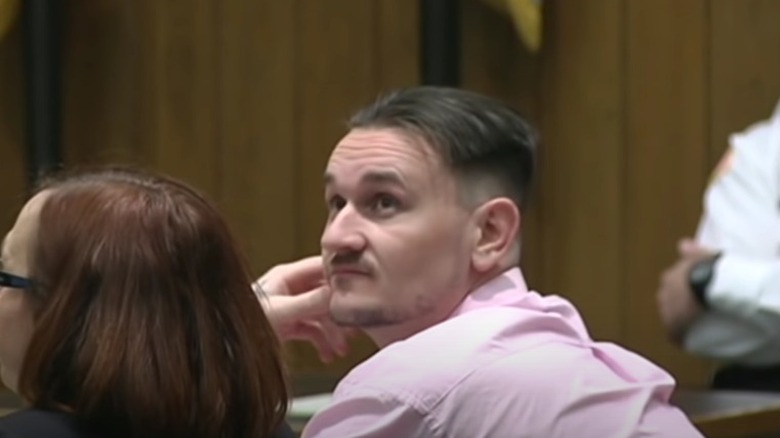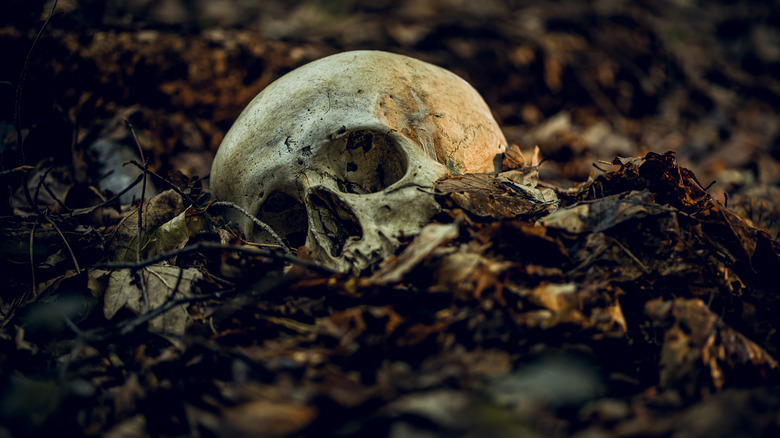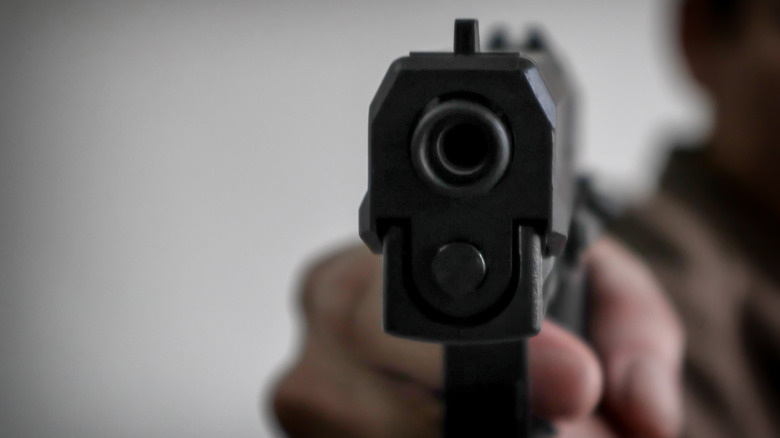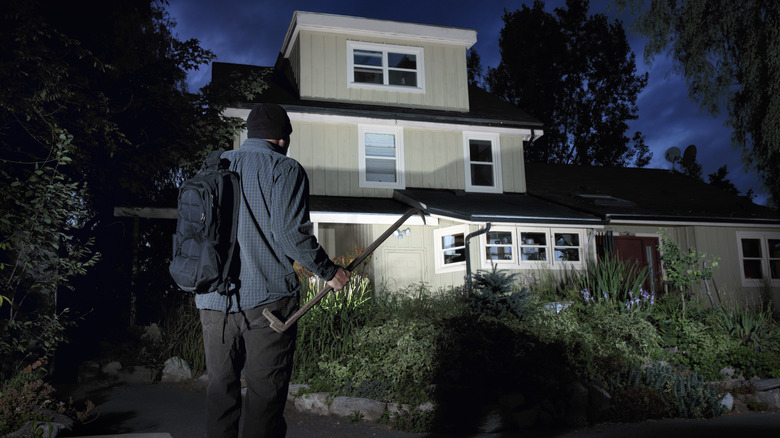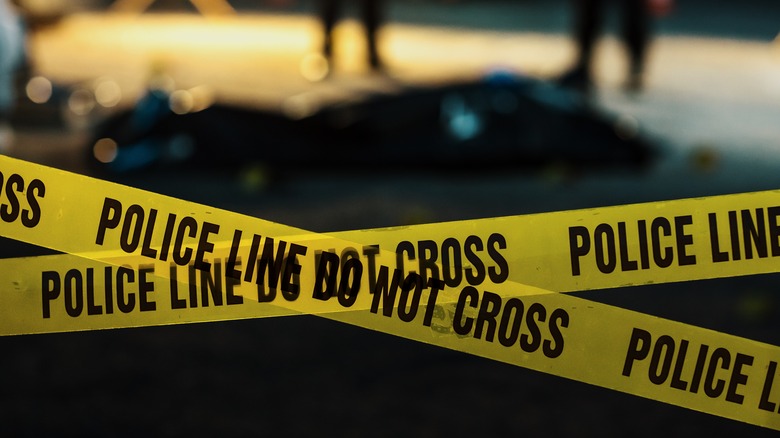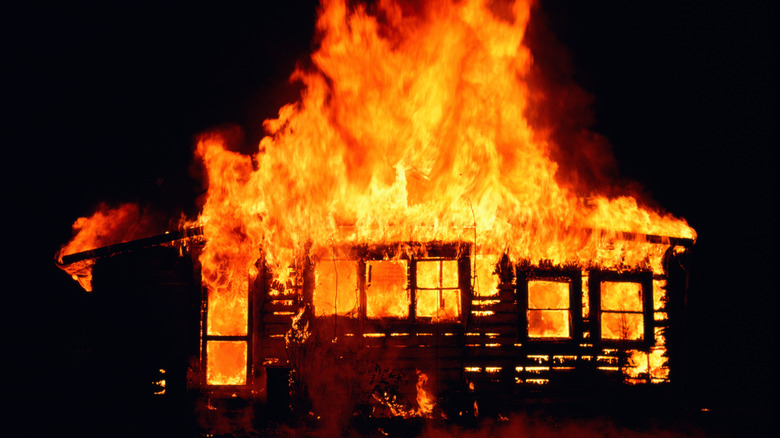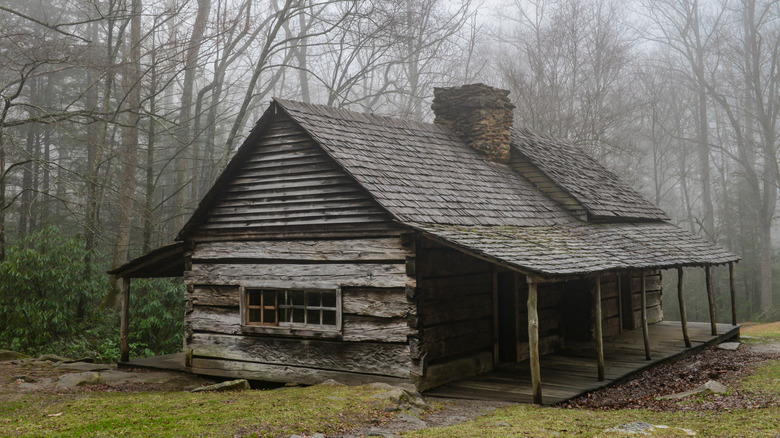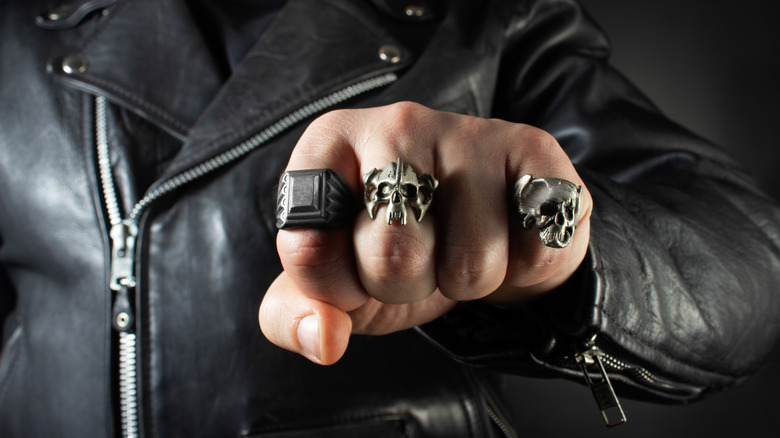The Worst Crimes The Hells Angels Ever Committed
Of all of the motorcycle clubs in existence in the U.S. and around the world, there are none so respected and feared as the infamous Hells Angels. That description of "motorcycle club" is also a bit of a misnomer; to the general public, the Angels are more likely to be called a "biker gang," and to law enforcement, they're likely to be described as an "organized criminal enterprise." Now, it may be a stretch to label all members of the Angels as hardened criminals, as there are probably quite a few who just like to ride their hogs, hang out in the clubhouse, and drink beer. It's also safe to say that if you want to join the club, you've generally got to be down for some pretty, shall we say, extralegal stuff.
Hells Angels chapters around the world have been the subject of often-fruitful investigations into organized criminal activities, such as drug dealing and manufacturing, gun running, and extortion rackets, and many of their members have been convicted of crimes ranging from petty to extremely serious. The cases we'll be looking at today fall squarely into the latter category, and be warned: some of these crimes are truly heinous, and many of the victims were among the most vulnerable members of society, so proceed with caution.
The following article includes allegations and descriptions of violence, sexual assault, and addiction.
The murder of Cynthia Garcia
In October 2001, members of the Mesa, Arizona, chapter of the Hells Angels took part in a crime straight out of a horror movie, for the pettiest of reasons — the perceived disrespect of Cynthia Garcia, a slight, 45-year-old woman who had been brought back to the clubhouse to party by a "prospect," a biker under consideration for membership in the club.
According to William Marsden and Julian Sherbook's "Angels of Death: Inside the Bikers' Global Crime Empire," Angels Kevin Augustiniak and Paul Eischeid — a former stockbroker — became violent with Garcia when she refused to participate in a sexual act; when she continued to berate the bikers, she was thrown to the floor and attacked until she lost consciousness. Augustiniak and Eischeid — accompanied by another Angel who would later become a witness for authorities — then threw Garcia in the trunk of a car and drove her out to the desert, where they stabbed her to death and partially decapitated her.
Augustiniak would be convicted of second-degree murder and sentenced to 23 years in prison, while Eischeid — who fled the country, but was extradited from Argentina in 2018 to face the music for his part in the crime — received a 19-year sentence on the same charge. The informant, Michael Kramer, would go on to prove invaluable to the cops, helping to bring down over three dozen of his fellow Hells Angels in five different states on various charges.
The Arvada, Colorado, shootout
In the summer of 2020, in the Denver-area neighborhood of Arvada, Colorado, local watering hole Jake's Roadhouse became the site of a furious gun battle between members of the Hells Angels and the Mongols — a rival biker gang. The dispute, which began in the parking lot of the establishment, quickly spilled out into surrounding blocks; bullets flew in all directions, motorcycles went screaming away from the scene, and fistfights broke out in the street. Before it was all over, one man — 43-year-old Hells Angel William Henderson (pictured above) — was dead of a gunshot wound, two of his friends were hospitalized with multiple gunshots, two uninvolved individuals were injured after being run off the road by fleeing bikers, and another was clinging to life after attempting to break up a fight.
That man: Ryan McPherson, the lead singer of Nightwolf, a classic rock band that had just finished up their first set when all hell broke loose. McPherson's bandmate Jay Halpern explained to CBS News that his buddy stepped in when he saw a man being beaten with a motorcycle helmet; that weapon was then turned on him, and he suffered a traumatic brain injury.
Seven months after the fact, ten individuals had been arrested in the subsequent investigation, and McPherson was still on the road to recovery, facing life-changing injuries as a result of the attack.
A triple murder in Massachusetts
David Glasser, whose life ended in 2011, spent his last few years in mortal fear of Adam Lee Hall (pictured above), Sergeant at Arms of the Berkshire, Massachusetts, chapter of the Hells Angels. A potential witness in an assault case that had been brought against Hall, Glasser had been threatened, intimidated, and even beaten up by the Hells Angel over those years. As it would be revealed in Hall's eventual murder trial, the campaign of harassment ended when Hall and two friends — Caius Veiovis, who was hoping to be considered for membership in the biker gang, and David Chalue, a member of the Aryan Brotherhood — abducted and murdered Glasser and two others, who simply had the bad luck to be present.
Glasser, his roommate Edward Frampton, and his friend Robert Chadwell were snatched from Frampton's home and taken to an undisclosed location, before they were shot dead and dismembered with a circular saw. The trio of criminals were undone by the testimony of another Aryan Brotherhood member, whom Chalue met in prison, and were all found guilty of the murders in 2014.
Imploring the judge to hand Hall the stiffest sentence possible, District Attorney David Capeless called the crimes "brutal, hateful assaults on three defenseless men" (via The Berkshire Eagle) — and the judge agreed, slapping Hall with three consecutive life sentences.
The brutal killing of a teenage girl
It took over a decade for Thomas Nesbitt to be brought to justice in Nebraska for the 1975 murder of Mary Kay Harmer, who was only 19 years old when she was unfortunate enough to cross the Hells Angel's path.
Harmer was a former high school friend of Kathleen Ray, who lived with Nesbitt; on November 30, Ray called to invite Harmer and her roommate, Gayla Jorgensen, to what she described as a housewarming party. It turned out to not exactly be that; Nesbitt was waiting at the house, and after the trio of women arrived, it wasn't long before Ray and Jorgensen exited the home, leaving Harmer alone with the biker.
While details are sketchy, it was outlined in court documents that Nesbitt later told Ray and his friend, next-door neighbor Wayne Bieber, that he "f***** up" over allegedly sexually assaulting the young woman, and after discussing a course of action with Ray, he killed her rather than risk her going to the authorities. Bieber later testified that he burned the woman's clothes, and the trio wrapped her body in carpet before dumping it in a manhole in an unfinished housing development. When her skeletal remains were found nine years later, forensic investigators were able to determine that Nesbitt had unsuccessfully attempted to dissolve Harmer's body with lye before disposing of it. Nesbitt was convicted of Harmer's murder in 1986, and sentenced to life in prison.
A horrific assault in Manhattan
In 1971, a phalanx of Hells Angels descended on New York City for the funeral of Jeffrey Coffey, one of their own who had been killed in Ohio the week prior. While in town, several of the men decided to order some new leather from Eugene Pritzert, who owned a leather goods store in the East Village. When they returned to pick up their order, they were told that it wasn't quite ready yet — and that's when all hell broke loose.
The gang of eight men first began beating up on Pritzert, but soon, a new target happened upon the scene — a 17-year old, female friend of the proprietor who was in town visiting him from California, and who had been napping in a back room. For six hours, the men guarded Pritzert while beating and sexually assaulting the girl, until Pritzert finally managed to escape and alert the police. All eight men fled the scene, but were later apprehended and identified in a lineup by their young victim; all were slapped with a bevy of charges, including sexual assault, criminal trespass, and unlawful imprisonment.
A tragic case of mistaken identity
In February 1988, Sandusky, Ohio, music store manager David Hartlaub was found shot to death beside his van. He had arrived at a bank to make his nightly deposit, and at first it appeared like a robbery gone wrong. It was not: police discovered that the deposit bag, containing around $4,000 in cash, had not been touched.
Eventually, police were able to draw a bead on those responsible, thanks to the cooperation of witnesses — including a co-worker who had followed Hartlaub and been threatened by a gun-toting man after spotting his body, and a woman who was able to describe their getaway car. The trio of men responsible were affiliated with the local Hells Angels chapter — and their targeting of Hartlaub was due to a tragic mistake on their part.
The men were attempting to eliminate a member of the rival Outlaw gang as payback for the shooting of one of their own a year prior — a man who happened to drive a van that was identical to Hartlaub's. Somehow managing to mistake a meek store manager for a hardened biker, the trio had jumped Hartlaub and shot him with a 9-millimeter pistol inside his van; one suffered a ricochet wound in the process, causing him to leave blood stains, and that evidence helped to nail the perpetrators. Wayne Yee, Mark Verdi, and John Ray Bonds were all convicted of conspiracy to commit murder and federal firearm offenses, and their subsequent appeal was tossed out.
A quadruple killing even hardened Angels couldn't condone
The brutal 1977 quadruple murder that took place in the rural town of Gaston, Oregon, ironically might never have been solved if not for its sheer brutality: Young children were killed in cold blood, an act savage enough to make hardened convicts and even Hells Angels to break their code of conduct and turn informant.
In August of that year, 24-year-old Margo Compton was murdered for the transgression of testifying in a pimping trial against Hells Angel Odis Garrett, an ex-president of the club's chapter in Vallejo, California, for whom she had served as a brothel-bound sex worker. Compton wasn't simply killed, though; acting on Garrett's orders, her murderer, Angel affiliate Robert McClure, first forced her to watch as he coldly executed her 19-year-old friend, Gary Seslar, and her 6-year-old twin daughters.
McClure and Garrett were not convicted of the brutal killings until 1994 and 1995, respectively, and their convictions were due to the cooperation of inmates, some Angels themselves, who were privy to McClure's boasts about the crime while he was imprisoned for other offenses. The two received identical sentences: four consecutive life terms in prison, one for each of the innocent lives they snuffed out.
A murderer walked free for years
As detailed in "Angels of Death: Inside the Bikers' Global Crime Empire," in 1969, the Hells Angels became known for wanton acts of violence almost immediately after getting a foothold in England. In 1984, a member of the Angels' Nomads chapter, David Richards, was sent to prison for life for upholding this reputation; for unknown reasons, he brutally murdered a 16-year-old boy, Michael Groves, at his girlfriend's home, stabbing him over 50 times and writing "Hells Angels" on the wall in his blood. Richards was sentenced to life in prison for the crime — but in 2005, he managed to escape, and neither hide nor hair was seen of him for nearly a decade.
Living under an assumed identity, Richards claimed disability benefits, went on vacations, and basically lived a normal life. When he was finally recaptured in 2014, Groves' family revealed that they were incensed at the perceived lack of effort on the part of authorities to snare Richards, chalking his apprehension up to "media appeals, not police work." In response, Derbyshire Assistant Chief Constable Karl Smethem explained that since Richards was from London, they assumed that he'd be hiding out there, which turned out not to be the case. "Although our procedures for searching for absconders has been improved since 2005, we are reviewing the system," he said (via The Standard).
The murders of Maureen and Telesforo Bautista
It's safe to say that being the girlfriend of a Hells Angel can be hazardous to one's health, and in the case of Maureen Bautista, it was fatal. According to court documents, Bautista's boyfriend and Hells Angels member, Robert Garceau, was involved in the manufacture of methamphetamine, and their relationship was a volatile one.
In the summer of 1984, Garceau became suspicious that Bautista was thinking of revealing his location to Eddie Nash, a drug dealer to whom Garceau was indebted (Garceau was known to misuse cocaine for days on end). In September of that year, his suspicions apparently overtook him — and he stabbed Bautista to death at her apartment in front of her 14-year-old son Telesforo, before turning the knife on the boy as well. He and several accomplices, all of whom played roles in his meth manufacturing operation, then smuggled the bodies out in a dresser and concealed them under freshly-poured concrete.
While no physical evidence linked Garceau to the crime, he apparently blabbed about it to anyone who would listen, apparently oblivious to the fact that even violent criminals frown on harming children. Indeed, some of Garceau's accomplices were among those who would testify against him at his trial in 1985, where he was convicted of first-degree murder and sentenced to death. Garceau died of cancer while on death row in 2004, at the age of 58.
The Grondalski family massacre
One of the most heinous crimes in the history of the Hells Angels was carried out by Gerald Lester and Charles Diaz, both members of the Vallejo chapter. As outlined in "Angels of Death: Inside the Bikers' Global Crime Empire," in 1986, William Grondalski was expelled from the Vallejo chapter for reasons that remain murky; authorities later determined that he may have kept contact open with Terry Dalton, a disgraced former member, and may also have been selling drugs on the side in his club's territory. Whatever the reason, in October 1986, Lester and Diaz paid a visit to his house — ostensibly to retrieve some gear and Angels' paraphernalia — which Grondalski shared with his wife Patty, his 17-year-old stepson Jeremy, and his five-year-old daughter Dallas.
An argument ensued, and Lester shot Grondalski in the face with a 9-millimeter pistol. Not wanting to leave any witnesses, he then shot Patty, then Jeremy. Diaz, the man Dallas called "Uncle Chuck," then attacked the young girl with a knife; Lester, complaining that it was taking too long to finish her off, shot her to death. The two then set the house on fire to attempt to cover up their crimes, but to no avail; they left behind enough evidence to point investigators in their direction, and both were eventually sentenced to life in prison.
Murder just for fun
While there is no shortage of innocents who have been brutalized simply for being associated with those facing retribution from Hells Angels, others have suffered the same fate for simply being in the wrong place at the wrong time. Such was the tragic, horrific case of Kevin Thorpe and Laura Craig, a young couple who, in 1981, had made the fatal mistake of stopping for some gas at a convenience store, where Hells Angel Benjamin "Psycho" Silva and two friends, Joseph Shelton and Norman Thomas, happened to be hanging out.
The trio had their eyes on Craig, and when the couple departed, they followed. They used a dashboard light to trick Thorpe into pulling over, and the nightmare began; Silva and Thomas forced their way into the vehicle, and with Shelton following in his car, they drove the couple to a remote cabin owned by Shelton. They tied Thorpe to a tree, leaving him outside in the blistering cold overnight while they repeatedly sexually assaulted Craig. Finally, Silva and Shelton untied Thorpe — only to lead him to a hilltop where they took turns shooting him with an assault rifle, emptying the 30-round magazine. Then, they simply drove Craig a short distance up the road, made her get out of the car, and shot her dead.
Silva and Shelton were eventually tried and sentenced to life in prison; Thomas, having provided evidence against them, received an 11-year sentence.
The killing of Bradley Parkhurst
Bradley Parkhurst was just a guy thinking about buying a motorcycle, who came by the wrong house and greeted the occupant in the wrong fashion. In February 1972, Parkhurst and his friend, Clyde Burk, went to the home of Connie Perry, who happened to be the girlfriend of a man who was tight with two Hells Angels — Russell Beyea and Marvin Gilbert.
Perry brought the visiting pair down to the basement, where Gilbert was working on a motorcycle frame, but when introduced, Gilbert commented negatively on the way Parkhurst shook hands, using a racial slur. When Parkhurst took offense, a fight broke out between Parkhurst and Gilbert; Perry ran to get Beyea, who quickly descended the stairs and pushed Burk up against the wall, holding him there. Gilbert then proceeded to basically beat and stomp Parkhurst until he was near death and begging for him to stop.
Gilbert and Beyea eventually did relent and left, leaving the others to try to tend to Parkhurst. When he began to slip away, they twice attempted to revive him by injecting him with methamphetamines, which prompted him to go into convulsions. After three and a half hours, Parkhurst died — and while his "caretakers" tried to convince authorities he had died of an overdose, the condition of his body left little doubt as to what had happened. Gilbert and Beyea were tried together for the crime, and both were found guilty of second-degree murder.
If you or anyone you know may be the victim of sexual assault, or needs help with addiction issues, contact the relevant resources below:
-
The Rape, Abuse & Incest National Network website or contact RAINN's National Helpline at 1-800-656-HOPE (4673).
-
The Substance Abuse and Mental Health Services Administration website or contact SAMHSA's National Helpline at 1-800-662-HELP (4357).
